
University of Utah electrical engineers have developed a network of wireless sensors that can detect a person falling.
This monitoring technology could be linked to a service that would call emergency help for the elderly without requiring them to wear monitoring devices.
For people age 65 and older, falling is a leading cause of injury and death. Most fall-detection devices monitor a person’s posture or require a person to push a button to call for help. However, these devices must be worn at all times. A 2008 study showed 80 percent of elderly adults who owned call buttons didn’t use the device when they had a serious fall, largely because they hadn’t worn it at the time of the fall.
Now, University of Utah electrical engineers Brad Mager and Neal Patwari have constructed a fall-detection system using a two-level array of radio-frequency sensors placed around the perimeter of a room at two heights that correspond to someone standing or lying down. These sensors are similar to those used in home wireless networks. As each sensor in the array transmits to another, anyone standing – or falling – inside the network alters the path of signals sent between each pair of sensors.
Mager is presenting the new fall-detection system Tuesday, Sept. 10 in London at the 24th Annual Institute of Electrical and Electronics Engineers International Symposium on Personal, Indoor and Mobile Radio Communications.
The team plans to develop this proof-of-concept technology into a commercial product through Patwari’s Utah-based startup company, Xandem Technology. The study was funded by the National Science Foundation.
“The idea of ‘aging-in-place,’ in which someone can avoid moving to a nursing home and live in their own home, is growing,” says Patwari, senior author of the study and associate professor of electrical and computer engineering at the University of Utah. “Ideally, the environment itself would be able to detect a fall and send an alert to a caregiver. What’s remarkable about our system is that a person doesn’t need to remember to wear a device.”
By measuring the signal strength between each link in the network – similar to the number of “bars” on your cell phone – an image is generated to show the approximate location of a person in the room with a resolution of about six inches. This imaging technique, called radio tomography, uses the one-dimensional link measurements from the sensor network to build up a three-dimensional image.
“With this detection system, a person’s location in a room or building can be pinpointed with high accuracy, eliminating the need to wear a device,” says Mager, a graduate student in electrical and computer engineering and first author of this study. “This technology can also indicate whether a person is standing up or lying down.”
The Latest Bing News on:
Fall detection
- Best Medical Alert Systems for Seniors With Hearing Loss, Tested and Reviewedon May 1, 2024 at 10:57 pm
Our Top PicksBest ValueBay Alarm MedicalBest customer serviceMedical GuardianBest hearing aid compatibilityLivelyOur Methodology: How We Chose the Best Medical Alert Systems for Seniors With Hearing ...
- VB firefighters join Crush Cancer causeon May 1, 2024 at 6:24 pm
Virginia Beach firefighters are joining the effort to Crush Cancer. Did you know that firefighter occupational cancer is the leading cause of line-of-duty death in the fire service? 10 On Your Side ...
- The Finals update 2.6.0 patch notes reveal way more than just a new modeon May 1, 2024 at 5:00 pm
Decreased damage from 25 to 22 Increased magazine size from 20 to 25 Increased the fall-off damage multiplier at max range ... certain players Several new suspension rules based on anomaly detection ...
- Amazon has the Apple Watch Series 9 at its best price everon May 1, 2024 at 6:44 am
It also comes with innovative fail-safe features like Fall Detection and Crash Detection that connect you with first-respondent services in the event of an emergency. Just as importantly, the watch is ...
- Bay Alarm Medical Alert System Cost and Fall Detection Pricingon April 30, 2024 at 10:44 pm
When it comes to medical alert systems, the primary goal is peace of mind. That’s why you want to select a provider with years of experience and a great reputation. Bay Alarm Medical certainly fits ...
- Automatic Emergency Braking With Pedestrian Detection to Become Mandatory on All New Carson April 30, 2024 at 11:22 am
NHTSA has announced that all new cars, SUVs, and pickup trucks must come with effective automatic emergency braking (AEB) technology by 2029.
- Fall Statistics And Facts In 2024on April 30, 2024 at 7:08 am
Meanwhile, falls are a leading cause of death in the U.S. among this age group, according to fall statistics from the Centers for Disease and Prevention (CDC). [1] Older Adult Falls Data. Centers for ...
- The Rise and Fall of the BolaWrapon April 29, 2024 at 10:05 am
The BolaWrap’s failure serves as a good reminder that SPD spends a lot of money on dumb, often useless tools under the guise of innovating their public safety strategies.
- Metal detectors planned for all Broward high schools this fallon April 23, 2024 at 11:49 am
The School Board agreed to fast-track a plan that was initially going to install metal detectors over two years.
- Apple Watch fall detection feature saves life of cyclists, calls emergency immediately after the man faintson April 19, 2024 at 1:56 am
Apple Watch's fall detection feature proves to be a lifesaver for a New York cyclist. After a severe biking accident, the smartwatch automatically dialed 911 and alerted emergency contacts, leading to ...
The Latest Google Headlines on:
Fall detection
[google_news title=”” keyword=”fall detection” num_posts=”10″ blurb_length=”0″ show_thumb=”left”]
The Latest Bing News on:
Fall detection system
- Best Medical Alert Systems for Seniors With Hearing Loss, Tested and Reviewedon May 1, 2024 at 10:57 pm
Our Top PicksBest ValueBay Alarm MedicalBest customer serviceMedical GuardianBest hearing aid compatibilityLivelyOur Methodology: How We Chose the Best Medical Alert Systems for Seniors With Hearing ...
- Bay Alarm Medical Alert System Cost and Fall Detection Pricingon April 30, 2024 at 10:44 pm
When it comes to medical alert systems, the primary goal is peace of mind. That’s why you want to select a provider with years of experience and a great reputation. Bay Alarm Medical certainly fits ...
- AI System Drops A Dime On Noisy Neighborson April 25, 2024 at 10:00 pm
There goes the neighborhood” isn’t a phrase to be thrown about lightly, but when they build a police station next door to your house, you know things are about to get noisy.
- Apple Watch Fall Detection Saves Cyclist After Bike Accidenton April 18, 2024 at 5:20 pm
Falling triggers tactile sensations, aural alarms, and on-screen notifications from the Apple Watch. Users can call 911 or dismiss the alarm using the watch's user interface. If it detects no reaction ...
- Apple Watch fall detection helps rescue cyclist after crash during downpouron April 18, 2024 at 9:47 am
Apple Watch is a must-have accessory for every cyclist. That’s become time and again it has proven critical for ...
- ADT Medical Alert Reviewson April 13, 2024 at 5:00 pm
System comes with a mobile base unit and a pendant with GPS location capabilities. It has a 40-hour battery life and optional fall detection. Includes a built-in microphone and speaker and ...
- Google could bring radar-based fall detection to the Nest Hubon April 6, 2024 at 5:00 pm
Google has filed a patent for fall detection via smart home devices using a radar system. The feature would notify an emergency contact or emergency services in the event of a fall. This suggests ...
- Best Medical Alert Systems With Fall Detection of 2024on April 5, 2024 at 7:16 am
A medical alert system with automatic fall detection means that it provides a wearable device that can hang from a lanyard or be clipped to the waistband or pocket and is equipped with technology ...
- Defying Mayor Brandon Johnson, aldermen seek to keep ShotSpotter on ward-by-ward basison April 1, 2024 at 3:25 pm
Monique Scott (24th) argued that Johnson's decision to keep ShotSpotter in place until the fall, and therefore ... a competing gunshot detection system, said their system is more precise than ...
- How to enable Fall Detection on the Samsung Galaxy Watchon March 18, 2024 at 5:00 pm
It's available on the Galaxy Watch 5, 5 Pro and 6 series. With fall detection enabled, your Samsung Galaxy watch will sound an alert and send an SOS message to designated emergency contacts if you ...
The Latest Google Headlines on:
Fall detection system
[google_news title=”” keyword=”fall detection system” num_posts=”10″ blurb_length=”0″ show_thumb=”left”]









